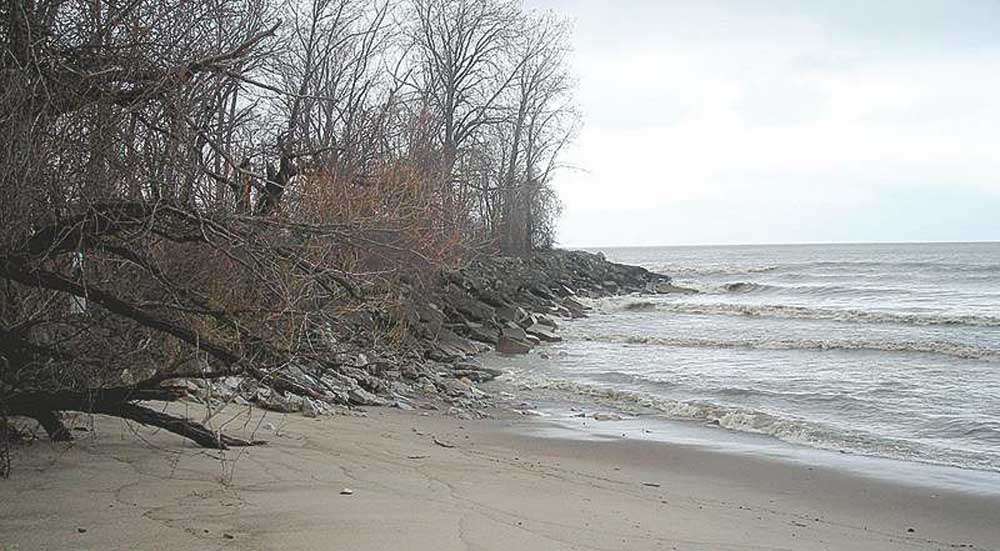Looking for birds in the wetlands
Published 1:02 pm Friday, December 13, 2013

- Visitors can find a wild, retreating Lake Erie barrier beach at Sheldon Marsh State Nature Preserve near Huron, Ohio. It stretches 1.13 miles and protects the wetlands from Lake Erie waves.
HURON, Ohio — Sheldon Marsh is not Magee Marsh. But the 465-acre state nature preserve on Lake Erie near Huron in Erie County in north-central Ohio is equally good.
Magee Marsh near Oak Harbor is generally hailed as the No. 1 birding spot in Ohio, especially its boardwalk, where migrating songbirds are often at eye level.
Trending
Sheldon Marsh is just as good. The only difference is that the migrating birds at Sheldon Marsh are in the tree tops, says Ryan Schroeder, the district preserve manager for the Ohio Department of Natural Resources. Nearly 300 species have been spotted at Sheldon Marsh.
The birds tend to feed and rest in the preserve’s wetlands and woods at the extreme eastern end of Sandusky Bay, before heading out across Lake Erie on their annual journey north to nesting grounds.
The preserve provides crucial habitat, shelter and food with its old farm fields, hardwood forests, woodland swamps, cattail marsh and open lake water. It is a critical stopover for migratory birds. It is also prime bald eagle country.
Every May, the preserve’s trees and shrubs are almost filled with colorful warblers, with 37 species recorded here. The L-shaped preserve also attracts waterfowl and shorebirds. You may see bald eagles and wading great blue herons. Rare sightings include golden-winged warblers, piping plovers, snowy owls and purple sandpipers.
Birders may love Sheldon Marsh, but the preserve also has another attraction: It is one of only three coastal wetlands in Ohio not diked for water management. It is some of the last remaining undeveloped shoreline in the Sandusky Bay area.
The preserve is also home to a wild and very distinctive Lake Erie barrier beach. Technically, it is a sand spit that nearly separates Lake Erie from the eastern end of Sandusky Bay. It is the best example of barrier beach in Ohio and is the last one of its size in Ohio on Lake Erie.
Trending
It stretches for 1.13 miles and protects the marsh from wave action. The crashing waves strike the white sand beach, not the biologically rich marshlands. It keeps Lake Erie waters from filling the wetlands that lie on the south side of the barrier beach.
You can explore the east-west beach on foot at the preserve between Huron and Sandusky. It is a 1-mile walk on a paved walkway from the parking lot off U.S. Highway 6 to the beach. You will pass several short side trails that lead off into the woods at the largely undeveloped preserve. Two wooden observation decks offer wetlands vistas.
Sheldon Marsh is one of the last remaining unspoiled sites where beach turns to marsh and then into mature forests like what once covered thousands of acres on Lake Erie’s southern shore. It is also one of the most-visited state nature preserves in Ohio.
The beach was once part of the original seven-mile-long roadway that led to the nearby Cedar Point amusement park. In fact, Sheldon Marsh was once the beginning of the main entrance to Cedar Point.
Today a brick-and-wrought-iron gate and a historical marker off U.S. 6 marks where the access road began with a toll booth and a flagpole.
In 1913, a motor road was extended from Cleveland Road north to the lakeshore and then six miles west along the beach to the amusement park. It was one of the first concrete roads built in Ohio.
The lake constantly washed away portions of the road and in 1919 the park owners were forced to construct an alternate route two miles west of the present-day preserve entrance. The remnants of the first road form the main walkway in Sheldon Marsh.
The beach itself is in retreat, moving to the south at up to 18 feet a year. It is being reshaped constantly by lake levels and storms.
In 1972, the west end of the barrier beach separated from the rest of the 6.5-mile-long Cedar Point sand spit due to a rise in lake levels and a major storm.
Over the last 40 years, the barrier beach has eroded westward and retreated about 1,200 feet in places. That created a broad U-shaped bay and shrank the marshland behind the beach.
Jetties built at Huron four miles to the east keep sand from depositing on the shore at Sheldon Marsh. The problem has been studied and analyzed over the years by federal and state agencies, with plans drafted to save and repair the barrier beach. It is a major engineering project. To date, the money has not been appropriated to proceed with restoration work.
Walk the beach to experience a touch of wild Ohio like it once was. The beach was formerly off-limits to visitors from May through September due to nesting birds: the common tern, a state-endangered species, and the piping plover, a federally threatened species. But that restriction has been lifted because neither species is nesting on the Sheldon Marsh beaches.
The beach is framed by two man-made features: a water pump station built by the federal government for the nearby NASA Plum Brook facility and private condominiums that sit on the spit to Cedar Point.
Sheldon Marsh remains relatively undisturbed, in part because of its previous owners. The original 56-acre tract was acquired in the early 1950s by Sandusky physician Dr. Dean Sheldon. It was nicknamed Sheldon’s Folly because much of the land was swampy and often under water.
An ardent conservationist, Sheldon spent many years improving the site for wildlife. That includes adding farm ponds and plantings that provide food and shelter for wildlife. He built a small cottage.
In 1979, the ODNR’s Division of Natural Areas and Preserve bought Sheldon’s property from his widow, Celestina.
The state added 330 acres of marsh and barrier beach and it was dedicated in 1980 as a state nature preserve. An additional 75 acres were added later, thanks to grants.
The preserve is known for its spring wildflowers that are at their colorful peak from mid-April through June. That includes Dutchman’s breeches, trout lilies and trilliums. It is also home to the cardinal flower, a striking red blossom that has been called America’s prettiest wildflower.
Hours are sunrise to sunset daily. Hunting, swimming, picnicking and collecting are prohibited.
If you go
For more information, you can contact the Ohio Department of Natural Resources, 614-265-6561, www.ohiodnr.gov and click on Recreation.
You can also get birding information at www.lakeerieohiobirding.info and www.wildohio.com.
Nearby the Erie Metroparks protects 1,400 coastal acres near Sheldon Marsh in what’s called East Sandusky Bay MetroPark. That includes the Community Foundation at Eagle Point, Putnam Marsh Nature Preserve, Joseph Steinen Wildlife Area, the Stockdale Arboretum, and Wyandot Wetland Meadows Preserve.
The parks, mostly marshy, are all accessible off Cleveland Avenue (state Route 2) and are just west of Sheldon Marsh. For more information, contact Erie MetroParks, 419-625-7783, www.eriemetroparks.org.
You can also make a historical stop nearby at Milan, where inventor Thomas A. Edison was born in 1847. Tour the red-brick house at the Edison Birthplace Museum, 9 N. Edison Drive, Milan, 419-499-2135, www .tomedison.org. You can also get information at www .milanohio.com.
It is open 10 a.m. to 5 p.m. Fridays and Saturdays and 1 to 5 p.m. Sundays.








